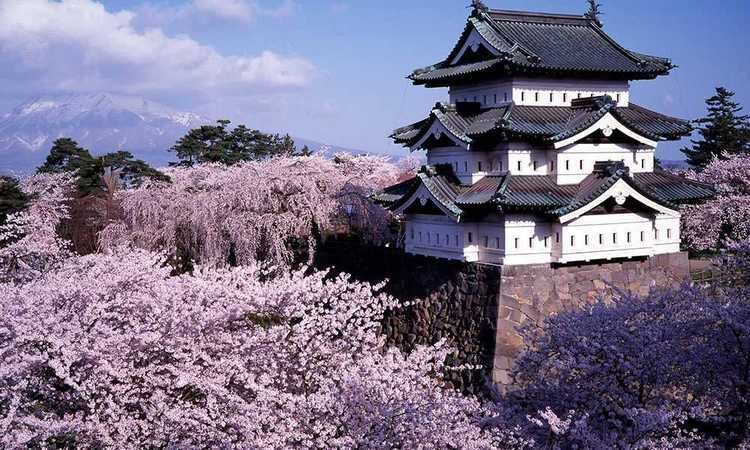- Flower Cherry Blossom Local time Sunday 12:53 PM | - Tree Apple tree Population 183,473 (2010) | |
 | ||
Weather 4°C, Wind NW at 14 km/h, 46% Humidity Colleges and Universities Hirosaki University, Hirosaki Gakuin University, Hirosaki University of Health, Tohoku Women's College, Tohoku Women's Junior Co | ||
Jr hirosaki station hirosaki city aomori prefecture
Hirosaki (弘前市, Hirosaki-shi) is a city located in southwest Aomori Prefecture, Japan. As of September 2015, the city had an estimated population of 176,590 and a population density of 337 persons per km². The total area was 524.20 square kilometres (202.39 sq mi).
Contents
- Jr hirosaki station hirosaki city aomori prefecture
- Map of Hirosaki Aomori Prefecture Japan
- Geography
- Neighbouring municipalities
- City emblem
- History
- Climate
- Economy
- Colleges and universities
- High schools
- Other schools
- Railways
- Highways
- Culture
- Local attractions
- Noted people from Hirosaki
- References
Map of Hirosaki, Aomori Prefecture, Japan
Hirosaki developed as a castle town for the 100,000 koku Hirosaki Domain ruled by the Tsugaru clan during the Edo period. The city is currently a regional commercial center and the largest producer of apples in Japan. The city government has been promoting the catchphrase "Apple Colored Town Hirosaki", and "Castle and Cherry Blossom and Apple Town" to promote the city image. The town is also noted for a large number of western-style buildings dating to the Meiji period.
Geography
Hirosaki is located in southwest Aomori Prefecture, in the Tsugaru plains in the southern Tsugaru Peninsula, south of Mount Iwaki and bordering on Akita Prefecture
Neighbouring municipalities
City emblem
Hirosaki uses a buddhist manji (similar to the swastika) as its official emblem. This came from the flag emblem of Tsugaru clan, the lords of Hirosaki Domain during the Edo era.
History
The area around Hirosaki formed part of the domains of the Northern Fujiwara in the Heian period; Minamoto Yoritomo awarded it to the Nambu clan in the early Kamakura period after the defeat of the Northern Fujiwara (1189). During the Sengoku period a local retainer of the Nambu, Ōura Tamenobu, declared his independence (1571) and seized local castles. He assisted Toyotomi Hideyoshi at the Battle of Odawara in 1590, and was confirmed in his holdings with revenues of 45,000 koku. He also changed his name to Tsugaru. After siding with Tokugawa Ieyasu at the Battle of Sekigahara, his revenues increased to 47,000 koku and he began construction of a castle in Takaoka (present-day Hirosaki). His successor, Tsugaru Nobuhira, completed the castle in 1611, but its massive 5-storey donjon was lost to lightning in 1627. The domain’s revenues increased to 100,000 koku in 1628.
In 1808, Takaoka was renamed Hirosaki. The Tsugaru clan sided with the Satchō Alliance in the Boshin War of the Meiji Restoration, and was rewarded by the new Meiji government with an additional 10,000 koku. However, with the abolition of the han system on August 29, 1871, Hirosaki Domain was abolished, and replaced by Hirosaki Prefecture. The Prefecture was renamed Aomori Prefecture in October of the same year, and the prefectural capital was relocated to the more centrally located Aomori.
Chōyō Elementary School was established on October 1, 1873. Apple horticulture was introduced to Hirosaki from 1877 and the 59th National Bank, the predecessor of Aomori Bank opened in March 1878. Hirosaki was proclaimed a city on April 1, 1889 and was thus one of the first 30 cities in Japan. The Ōu Main Line connected Hirosaki with Aomori on December 1, 1894.
Hirosaki became the home garrison town for the Imperial Japanese Army’s IJA 8th Division from October, 1898. The division was prominently active in the Russo-Japanese War.
Hirosaki City Hospital was established in 1901, and Hirosaki City Library in 1906. The first telephone service in the city stated from 1909. The first Cherry Blossom Festival was held in 1918. In 1927, the Kōnan Railway connected Hirosaki with Onoe. Hirosaki University was established in 1949.
On March 1, 1955, Hirosaki expanded through annexation of neighboring villages of Shimizu, Wattoku, Toyoda, Horikoshi, Chitose, Fujishiro, Niina, Funazawa, Takasugi, Susono and Higashimeya. Nishimeya became an enclave. The city further expanded on September 1, 1957 through annexation of neighboring Ishikawa Village.
The First Chrysanthemum and Maple Festival took place in 1964 and the First Hirosaki Castle Snow Lantern Festival in 1977. In 1979, the city was connected to the Tōhoku Expressway by a spur road named “Apple Road”.
On November 15, 2006, the town of Iwaki, and village of Sōma (both from Nakatsugaru District) were merged into Hirosaki.
Climate
Hirosaki has a hot humid continental climate (Köppen: Dfa) characterized by short warm to hot (and often humid) summers and cold winters with heavy snowfall.
Economy
Hirosaki is the regional commercial center for southwest Aomori Prefecture. The main agricultural crops include apples and rice, with Hirosaki accounting for 20% of the total production of apples in Japan.
Colleges and universities
High schools
Prefectural
Private
Other schools
Hirosaki has 35 elementary schools, 15 city, one national and one private middle schools, one combined elementary/middle school and four special education schools.
Railways
Highways
Culture
Hirosaki is known for its tradition of Tsugaru-jamisen, a virtuosic style of shamisen playing. It is the site of shrine.
Local attractions
Hirosaki is known for its Cherry Blossom Festival held in the park surrounding Hirosaki Castle. About 2,600 Sakura (Japanese cherry) blossom during the Japanese Golden Week vacation period. The Hirosaki Neputa Festival is held during the first week of August and is one of the 100 Soundscapes of Japan by the Ministry of the Environment
